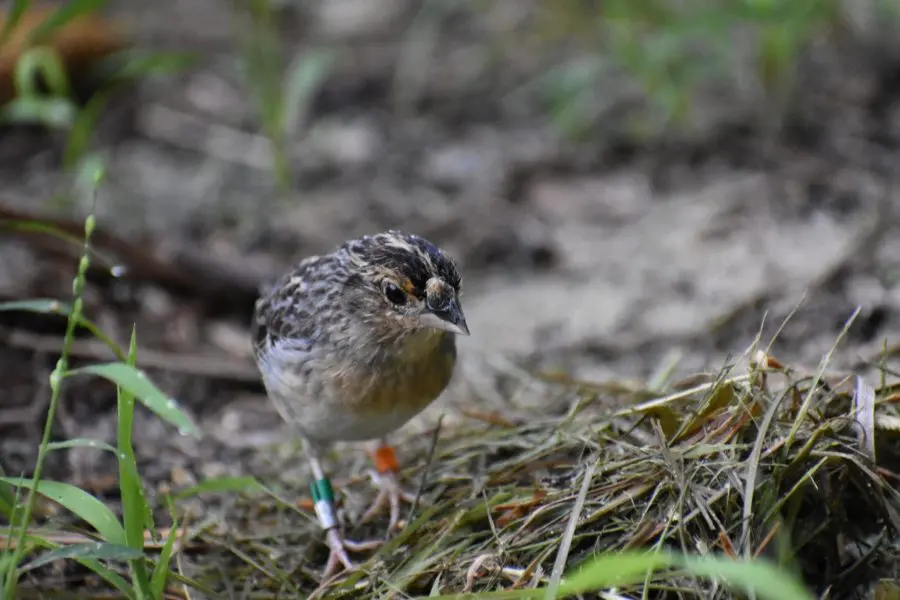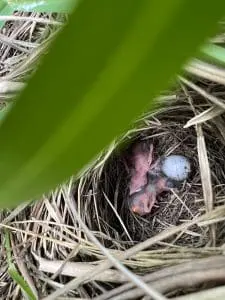

We’re thrilled to share that our second breeding season for the critically endangered Florida grasshopper sparrows has ended with incredible success! Thanks to our four pairs of sparrows and their animal care team, 65 birds were hatched this year! Most have been released back to their native range, but we still have some young chicks in our behind-the-scenes habitats who have a little more growing up to do before being released.
“Our successful breeding season is great for our sparrows in human care because it means we can continue diversifying the genetics of the sparrows we’re breeding and releasing every year,” said conservation coordinator Kelly Currier. “It helps us maintain a healthy breeding flock.
“The season’s success also means more sparrows are able to be released in general, adding to the wild population and strengthening their numbers within the landscape.”
Our Zoo is part of a collaborative conservation effort to save this species with the Florida Grasshopper Sparrow Working Group, Florida Fish and Wildlife Conservation Commission, United States Air Force, U.S. Fish and Wildlife Service and Archbold Biological Station.
This species is found only in a few areas of Central and South Florida. In 2021, just over 100 members of their species were found in their natural range. Last year was our first breeding season with our sparrows, and we were proud to release 47 birds.
 This year’s breeding season began back in the spring, when the males began the process of signaling their interest to the females to breed through a buzzing sound, and nest building, and egg laying followed. After several weeks, our first chicks were hatched – and that was just the beginning of this amazing success story.
This year’s breeding season began back in the spring, when the males began the process of signaling their interest to the females to breed through a buzzing sound, and nest building, and egg laying followed. After several weeks, our first chicks were hatched – and that was just the beginning of this amazing success story.
The newly hatched chicks stayed with their parents for 21 days, after which they were moved to another behind-the-scenes habitat at the Zoo and monitored to ensure their wellbeing before release. Once matured and medically cleared, each clutch (or group) of chicks was released into their natural range.
Once the chicks were separated, their parents would restart the breeding process of buzzing, nest building and egg laying!
Sparrows Ava and Gator produced this year’s largest single clutch of eggs – five – along with the most hatched chicks: 24!
“This breeding season was likely so successful because the birds had everything they needed to feel safe and be well fed,” Kelly said. “For example – a plethora of bugs to eat, not a lot of outside stress near the aviaries, and the right plants to hide under and make nests out of. It also could have been ideal weather and lack of big storms this season that made this season more successful.”
 This year, our Zoo participated in an egg swap in order to bring in new genetics for breeding flocks. To make this happen, studbook keepers worked with field crews to target a nest that will add the most genetic diversity to our existing flocks. We had a nest here at the Zoo that was similar in incubation age. Our animal care team transported the eggs via incubator out to the field and switched out the eggs with zoo eggs. The field eggs were brought back to the Zoo and put under incubating mom Ava, after which she hatched and raised all of them!
This year, our Zoo participated in an egg swap in order to bring in new genetics for breeding flocks. To make this happen, studbook keepers worked with field crews to target a nest that will add the most genetic diversity to our existing flocks. We had a nest here at the Zoo that was similar in incubation age. Our animal care team transported the eggs via incubator out to the field and switched out the eggs with zoo eggs. The field eggs were brought back to the Zoo and put under incubating mom Ava, after which she hatched and raised all of them!
These chicks will likely be given to our partners to be included in their conservation breeding programs.
“The success of the FGSP project comes from understanding the genetics and proper pairing of the birds, so having these wild genes brought in is very diversifying to the genetic future of the sparrows,” Kelly said.
It’s time for our four sparrow pairs to rest! As of now, all of the pairs are set to stay the same next year. We look forward to continuing to help this critically endangered species bounce back!
Brevard Zoo is an independent, not-for-profit organization that receives no recurring government funding for our operating costs. Your generous support enables us to continue to serve our community and continue our vital animal wellness, education and conservation programs.